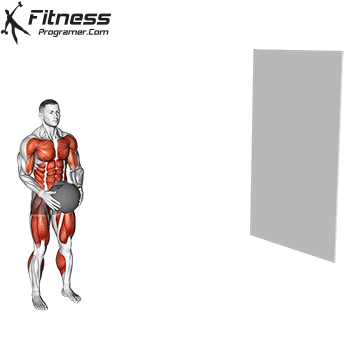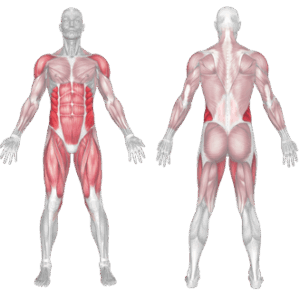Overview
The Step-Behind Rotational Med Ball Throw is an advanced power development drill used in rotational sports like baseball, golf, MMA, and tennis. This is a dynamic, high-velocity rotational throw where the athlete steps behind with one foot and rapidly rotates to toss a medicine ball against a wall or into open space. The movement mimics sport-specific actions like a swing, punch, or shot. It develops explosive rotational strength, hip-to-core transfer, and neuromuscular coordination.
How to Perform

Start Side-On to a solid wall or open space, holding a light medicine ball (2–6 kg).
Stand tall with feet shoulder-width apart and the ball held at waist height.
Step your rear foot behind and across your front foot (like a crossover step).
As your rear foot lands, rotate your hips toward the wall and transfer your weight forward.
Explosively rotate your torso and shoulders, releasing the ball in a side-throw motion.
Allow full hip and shoulder rotation, finishing tall and balanced.
Reset between reps and repeat on the opposite side.
Tips for Proper Form
Start light (2–4 kg ball) to prioritize speed and mechanics.
Step behind with control, but rotate explosively on the throw.
Keep the ball close to the torso before release to avoid arming the throw.
Finish tall—do not fall forward or collapse after the throw.
Exhale forcefully as you release the ball for added core engagement.
Use a non-bouncy wall or open field for safety and fluidity.
Common Mistakes
Arming the throw without using the hips and legs.
Skipping the step-behind, making it more of a stationary throw.
Throwing too heavy, which slows down rotation and reduces transfer.
Over-rotating or falling off balance after release.
Not switching sides, creating strength asymmetries.
Benefits of Step-Behind Rotational Med Ball Throw
Develops Explosive Rotational Power: Trains speed and force transfer from the ground through the hips to the hands.
Improves Athletic Transfer: Mimics movements used in sports like baseball, golf, tennis, hockey, and martial arts.
Enhances Kinetic Chain Sequencing: Builds intermuscular coordination between lower and upper body for efficient rotation.
Improves Core Speed and Strength: Targets the obliques, transverse abdominis, hip rotators, and spinal stabilizers.
Teaches Directional Control: Helps athletes learn how to direct power accurately and repeatably.
Increases Agility with Power: The step-behind improves coordination, balance, and direction change ability under speed.
How to Incorporate Into Your Routine
- For Athletic Power: 3–4 sets of 3–5 throws per side before weight training or as part of a power warm-up.
- For Rotational Sport Training: Perform 2–3x/week in-season or off-season, paired with sport-specific drills.
- For Functional Fitness: Include in circuits or core finishers for movement skill and rotational capacity.
- For Rehabilitation: Begin with slower, lighter versions under supervision to restore patterning.
- For General Fitness: Use as a dynamic warm-up or cardio-power drill to keep core training athletic.
Muscles Worked

Frequently Asked Questions
Is this safe for beginners?
Yes, if performed with light balls, proper coaching, and gradually progressed. Emphasize mechanics before intensity.
How heavy should the medicine ball be?
Start with 2–4 kg (4–9 lbs). Prioritize speed and form. Avoid heavy throws that slow rotation.
Which athletes benefit the most?
Athletes in golf, baseball, tennis, boxing, hockey, and field sports. Also valuable for CrossFitters and MMA fighters.
Can this replace traditional core work?
It complements it. Traditional planks and crunches build endurance, while this builds explosive function.
What surfaces are best for throwing?
Use a concrete or rubberized wall, or throw into an open field. Avoid highly elastic surfaces.
